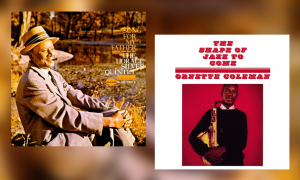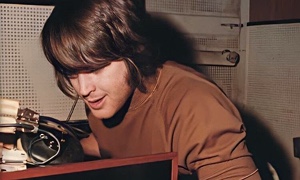Home » Jazz Articles » Building a Jazz Library » CTI Records: Ten Tasty Albums With No Added Sugar (Almost)
CTI Records: Ten Tasty Albums With No Added Sugar (Almost)

Something that backfired on me is being responsible in a very odd way for smooth jazz, that nonentity of floating backgrounds. But I had no intention whatsoever of producing background music. The fundamental thing, always, whatever idiom of music we recorded, was to go for a groove.
—Creed Taylor
Taylor cut his teeth in the record business in the 1950s, first with the independent Bethlehem, then with ABC-Paramount, gaining a reputation as a marketing-savvy producer. In 1960, he persuaded ABC to launch Impulse! with himself as producer/artistic director. Among his first signings was John Coltrane, whose label debut, Africa/Brass (1961), he produced. "I didn't really produce it," Taylor said a few years later. "You don't produce John Coltrane. I just made sure he and Rudy [Van Gelder] had what they needed."
In any event, by the time Africa/Brass was released, Taylor had left Impulse!, crossing Broadway to accept a lucrative offer as head of Verve, where with Stan Getz and others he forged the high-gloss production template that he perfected at CTI.
Taylor launched CTI in 1967 under the umbrella of A&M, who handled its sales and distribution, and took it fully independent in 1970. After expanding too far, too fast, Taylor was obliged to keep the label afloat with a $600,000 loan from Columbia. In 1978, unable to make the repayments, he declared the company bankrupt. Columbia acquired the catalogue under the terms of the loan agreement.
In a 2005 interview, Taylor reflected on the arguments his CTI productions caused and continue to cause. "Something that backfired on me is being responsible in a very odd way for smooth jazz, that kind of nonentity of floating backgrounds," said Taylor. "But I had no intention whatsoever to produce background music for beautiful people purposes."
Taylor went on to say that for him the CTI signature was rhythmic. "The fundamental thing, always, whatever idiom of music we recorded, was to go for a groove. We might keep the rhythm section playing for an hour on the same twelve bars. When it begins to sound like it's just about to lock in, then you start to record... You need a swinging foundation on which to put the improvisation. It's like batting practice and pitching warm-ups before a baseball game. Then you come out and perform. I don't see any difference. Of course, you have to start off with a good song."
With one exception, this list of Top Ten CTI albums avoids the label's more softly cushioned productions. It starts with an album which is among hard bop's most enduring late-period releases.
CTI RECORDS: TEN ALBUMS THAT EVERYONE SHOULD HEAR
 Freddie Hubbard
Freddie Hubbard Red Clay
1970
Ten years after his sensational Blue Note debut album, Open Sesame (1960), and almost forty years before his swansong, Red Clay is trumpeter Freddie Hubbard's final undeniable artistic success under his own name. It made limited concessions to what would become trademark CTI-style jazz funk, but kept all but the most purist of Hubbard's Blue Note fans happy, too.
After a string of top ranking Blue Note follow-ups during the first half of the 1960s, as jazz ceded ground to rock and soul as the decade continued, Hubbard looked to fusion to shore up his income. But his heart was not in it; he usually ended up sounding cheesy, and the viscerally exciting style with which he had made his name degenerated into clichés and histrionics. The decline began on Atlantic towards the end of the 1960s and accelerated during the 1970s, first on CTI, then on Columbia.
Red Clay, Hubbard's CTI debut, bucked the downward spiral. Hubbard's chops are still killer and the band is a monster: Joe Henderson is on tenor saxophone and flute, Herbie Hancock on piano and Fender Rhodes, Ron Carter on bass and Lenny White on drums.
By the early 1980s, Hubbard had little to show for his pursuit of mammon other than a Brobdingnagian cocaine habit and, as he was unable to disguise in press interviews, a quantity of self disgust. There was, however, something approaching a happy ending: Hubbard's final studio album, On The Real Side (Times Square, 2008), is a more than decent effort.
 Joe Farrell
Joe Farrell Outback
1972
Saxophonist and flautist Joe Farrell was a first-call CTI sessionman and he also recorded for the label under his own name. Like Red Clay, Outback is no nonsense hard-core jazz of the first order. Playing tenor and soprano saxophones and flute and alto flute, Farrell leads another high-grade quintet comprising Chick Corea on electric piano, Buster Williams on bass, Elvin Jones on drums and Airto Moreira on percussion.
The musicians already knew each other. Farrell had appeared on three Jones albums, Puttin' It Together (1968), The Ultimate (1969) and Poly-Currents (1969), all on Blue Note. Farrell and Moreira had been founder members of Corea's Return to Forever a year or so previously. Williams, a member of Herbie Hancock's band, moved in the same circles.
Again like Red Clay, Outback consists of four tracks, the longest lasting 09:25 minutes, permitting well-crafted, evolving, ensemble passages and plenty of solo space (in this case, mainly from Farrell and Corea). The album opens with an ostinato-driven version of the theme tune from the movie Outback and showcases Farrell's flutes. It is followed by a soprano saxophone feature, the Farrell original "Sound Down," on which he tips his hat to John Coltrane on a section which shifts into waltz time and suggests "My Favourite Things." Farrell stays on soprano for Corea's Spanish-tinged "Bleeding Orchard" but essays a grittier, vocalised tone. The closer, the Farrell original "November 68th," has him on gutsy inside/outside tenor.
 Chet Baker
Chet Baker She Was Too Good To Me
1974
Warning! This album contains added sugar.
She Was Too Good To Me was billed as a comeback album, following the great but troubled trumpeter Chet Baker's five-year descent into out-of-control heroin use and a lengthy battle to rebuild his embrochure after a front tooth was knocked out in a street brawl in San Francisco. Concerned about Baker's chops, Taylor (who had first worked with him at Bethlehem in the early 1950s) surrounded him with session men and cushioned him on some tracks with a string section. A supportive framework was just what Baker needed at the time and he responds with some wonderfully lyrical playing.
Incidentally, dental problems are also the reason the friendly-by-nature Baker is only ever shown giving a Mona Lisa-like half-smile in the image-building photos William Claxton shot during the early 1950s. He had already lost one front tooth. In his book Young Chet (Te Neues, 1993), Claxton says: "As long as I knew Chet he had one missing tooth in the front that made him look charming and dopey at the same time. And [he made sure that] the missing tooth never showed up in any of his pictures." (An exception is a 1953 photograph taken by a fan backstage at a Los Angeles club. Baker is shown standing next to Miles Davis. So thrilled is Baker to be in the presence of his hero that he forgets to keep his lips closed and grins broadly).
Seven of the eight tracks on She Was Too Good To Me are from the Great American Songbook, with "Autumn Leaves" and "Tangerine" especially memorable. Alto saxophonist Paul Desmond (who had first recorded with Baker in 1951) is the perfect guest soloist on several tracks. Flautist Hubert Laws, who was all too capable of inconsequential fusion, raises his game on Hank Mobley's "Funk In Deep Freeze."
The album finds Baker well on the way to a return to form (though not a recovery from heroin addiction). His best recorded work of the 1970s, however, is arguably as a sideman with guitarist Jim Hall....
 Jim Hall
Jim Hall Concierto
1975
Jim Hall's Concierto has arrangements by CTI house arranger Don Sebesky, much of whose work fluctuated between the brash and flash and the sweet and cloying, but sometimes—as here—satisfying the most discerning listener. The album may be CTI's all-time best. It is certainly one of Hall's best.
Taylor's uncluttered production and Sebesky's understated arrangements play to Hall's elegance and lyricism. The album was made with a sextet: Paul Desmond on alto saxophone Chet Baker on trumpet, Roland Hanna on piano, Ron Carter on acoustic bass and Steve Gadd on drums.
Side one of the original LP consisted of Cole Porter's "You'd Be So Nice To Come Home To," Jane Hall's "The Answer Is Yes" and Hall's "Two's Blues." They are gorgeous. But it is side two that is Concierto's crowning glory: an adaptation of Joaquin Rodrigo's "Concierto De Aranjuez." Baker sounds totally unfazed by Miles Davis' historic performance on Sketches Of Spain (Columbia, 1960), and his melodicism is at its most elevated. Hall's ditto. Sebesky's loosely swinging charts are "jazzier" than Gil Evans' orchestrations for Davis. An essential album.
 Randy Weston
Randy Weston Blue Moses
1972
Pianist and composer Randy Weston spent most of the 1960s and early 1970s in Morocco, where he became immersed in the trance music of African-Berber brotherhoods such as the Gnawa and Jilala. Blue Moses, his only CTI album, is a suite inspired by, though some distance removed from, this music.
The album is not, as you might expect, a percussive, small group affair such as African Rhythms (Comet, 1970) or Spirit: The Power Of Music (Sunnyside, 2000). It is a big-band production featuring a brass-dominated 22-piece line-up arranged by Don Sebesky.
Sebesky's approach here is high decibel and borderline bombastic (early in his career he played trombone in Stan Kenton's orchestra) and quite unlike that of Weston's preferred arranger on middle and large-sized ensemble projects, Melba Liston (also, coincidentally, a trombonist). Sensibly, Weston, on electric and acoustic piano, goes with the flow, and only takes one solo, on the closer, "Marrakesh Blues." Each of the four tracks, however, includes kicking solos from Freddie Hubbard on trumpet and straight-ahead mode Grover Washington, Jr. on tenor saxophone.
Enjoyably high octane, Blue Moses adds another dimension to Weston's output.
 Antonio Carlos Jobim
Antonio Carlos Jobim Stone Flower
1970
Creed Taylor's love affair with Antonio Carlos Jobim's tunes began at Verve in 1962 when he began producing Stan Getz's bossa nova albums. They were followed by Jobim's first own-name Taylor production, The Composer Of Desafinado, Plays (Verve, 1963). This cherry-picked a dozen of Jobim's most popular pieces and featured him playing piano and guitar framed by the rococo orchestrations of Claus Ogerman.
Among Taylor's first CTI productions was Jobim's Wave (1967), another collection of Jobim tunes framed by Ogerman's arrangements. Next up were 1970's Stone Flower and Tide, both with jazz-centric arrangements by fellow Brazilian Eumir Deodata. The vibe is in the main burnished and laid-back, the exception being Hermeto Pascoal's raw, vocalised-flute solo on Tide's "Tema Jazz." (Some CD reissues of Tide usefully include the 08:11 master take of "Tema Jazz" with Pascoal's complete solo, which was edited down for the 04:35 track on the original LP).
The CTI Jobims may seem to fly in the face of the title of this article. But their lush aesthetic derives more from Jobim than Taylor. First generation Brazilian bossa nova was smooth long before that became a dirty word.
 Bill Evans
Bill Evans Montreux ll
1970
A memorable follow-up to pianist Bill Evans' Grammy Award-winning At The Montreux Jazz Festival (Verve, 1968). The trio line-up retains Eddie Gomez on bass and replaces Jack DeJohnette with Marty Morrell. Although Creed Taylor is credited as producer on some editions, the album was actually produced (albeit only nominally) by Evans' manager, Helen Keane. Taylor's involvement was more or less limited to having Rudy Van Gelder do some work on the tapes prior to mastering.
Evans worked from a relatively small songbook throughout his career and the material here is familiar fare. But he imbues it with the fresh, seraphic lyricism that he brought to practically every performance. There are three originals ("Very Early," "34 Skidoo" and "Peri's Scope"), two Great American Songbook standards (Earl Zindars' "How My Heart Sings" and Jack Baker's "I Hear A Rhapsody), and Burt Bacharach's "Alfie" and John Carisi's "Israel."
None of Evans' trio albums top the masterpieces he recorded with bassist Scott LaFaro and drummer Paul Motian in 1960-61, or those with drummer Philly Joe Jones between 1958 and 1978. Those albums—along with the duo project Undercurrent (United Artists, 1962) made with Jim Hall—are the foundation of an Evans library. But Montreux ll, Evans' only CTI release, is among the next batch of acquisitions.
 George Benson
George Benson Beyond The Blue Horizon
1971
Much of guitarist George Benson's work is inconsequential fusion, but he can do better when the fancy takes him. There was a reason that Miles Davis had Benson replace Joe Beck as guitarist for the sessions which produced Miles In The Sky (Columbia, 1968), on which Benson fills out the chording and takes a brief solo on Wayne Shorter's "Paraphernalia." (He also plays on two other tracks from the same sessions which were later included on Columbia's 1979 catch-up, Circle In The Round).
In 1971, when Benson's CTI debut, Beyond The Blue Horizon, was recorded, his jazz chops were still match-ready and in full effect. The album is one of his best, possibly his very best, jazz outings. As Benson tells the tale in Benson: The Autobiography (Da Capo, 2014), this is partly because, having just taken CTI out from under A&M's wing and made it fully independent, Taylor "didn't have no money to put any sweetening on it, no strings or anything like that. [So] I thought, I'll just get some great cats, pick some great tunes, and play some great guitar."
Which he does. Clarence M. Palmer keeps things soul-jazzish on the Hammond B3, while Ron Carter, on double bass, and Jack DeJohnette, on drums, maintain a relatively straight-ahead post-bop groove. Michael Cameron and Albert Nicolson provide additional percussion. The album opens with an up-tempo version of Davis' "So What," which includes a smoking-hot guitar solo. Things cool, just a little, during the next track, Luiz Bonfa's bossa nova "The Gentle Rain." Side two consists of three Benson originals, closing with the stand-out "Somewhere In The East," where the guitarist's Eastern-tinged harmonies and the tabla-esque percussion suggest world-jazz a decade or so before the event.
 Ron Carter
Ron Carter All Blues
1974
By the time Ron Carter left Miles Davis' band in 1968, he was one of jazz music's most in-demand session players and had been present on many hundreds of releases (his total in 2020 is in excess of 1,500). In Miles: The Autobiography (Simon & Schuster, 1989), Davis notes Carter's kvetching when the band's itinerary took it beyond easy reach of New York, where the bassist earned far more per week in the studios than he did on the road with Davis.
Carter was a regular sessionman on CTI from the get-go, when he played bass on the label's debut release, Wes Montgomery's A Day In The Life (1967). Many more CTI gigs followed: indicatively, Carter is a bassist on seven of the other nine albums in this Top Ten.
Many of Carter's CTI albums are lightweight affairs, be they sideman or leader dates, but All Blues is a keeper. Aside from one track on which Richard Tee plays generic fusion keyboards, the album has an atypically singular lineup: Joe Henderson on tenor saxophone, Roland Hanna on piano and Billy Cobham on drums. The highlight is an unhurried nine-minute version of Miles Davis' "All Blues," on which Henderson delivers a breathtakingly gorgeous solo. Hanna shines on two (of four) Carter originals, "Light Blue" and "Rufus."
 Milt Jackson
Milt Jackson Sunflower
1973
Overall, vibraphonist Milt Jackson's 1970s CTI albums have not endured as well as his 1960s work on Riverside and Impulse!, or before that with Atlantic. But Sunflower, a thoughtful blend of straight-ahead and fusion which makes the most of the vibraphone's ethereal qualities, is up there with such milestones as Soul Brothers (Atlantic, 1958), co-headlined with Ray Charles, and Bags Meets Wes (Riverside, 1962), with Wes Montgomery.
Like Carter's All Blues, much of the success of Sunflower derives from its focus on the band rather than the leader. And what a band: Freddie Hubbard on trumpet and flugelhorn, Herbie Hancock on keyboards, Jay Berliner on guitar and Billy Cobham on drums. The group is augmented by sympatico Don Sebesky-arranged woodwinds and strings. The strongest track is Hubbard's Spanish-tinged "Sunflower," but Michel Legrand's "What Are You Doing For The Rest Of Your Life?" runs it close.
Conventional wisdom has it that, outside the disciplined context of the MJQ, Jackson was most effective letting his hair down with the blues. Certainly, his Atlantic albums confirm his mastery of that form. But Sunflower reminds us what a great ballad interpreter he was, too, with or outwith the MJQ.
Photo: Chet Baker
Tags
PREVIOUS / NEXT
Support All About Jazz
 All About Jazz has been a pillar of jazz since 1995, championing it as an art form and, more importantly, supporting the musicians who make it. Our enduring commitment has made "AAJ" one of the most culturally important websites of its kind, read by hundreds of thousands of fans, musicians and industry figures every month.
All About Jazz has been a pillar of jazz since 1995, championing it as an art form and, more importantly, supporting the musicians who make it. Our enduring commitment has made "AAJ" one of the most culturally important websites of its kind, read by hundreds of thousands of fans, musicians and industry figures every month.























